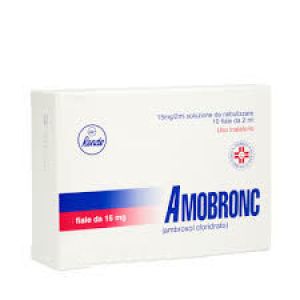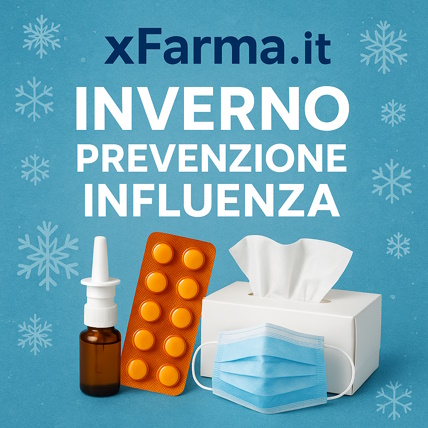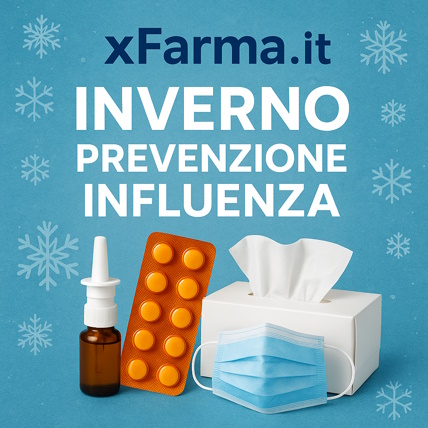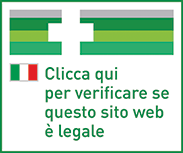Ship in Europe, Find out rates!
Language
Amobronc Inhalation Solution 2ml 15mg Ambroxol Hydrochloride 10 Vials

Regular Price
€17.00
Special Price
€15.39
-9%
Save: €1.61
Out of stock
- box Delivery in Italy in 24/48 and free returns
- star3.000+ positive reviews
- dropboxOver 60,000 products in the catalog
Manufacturer
IST.CHIM.INTERNAZ. RENDE
SKU
025776030
Active principle
AMBROXOLO CLORIDRATO
NAME
AMOBRONC
PHARMACOTHERAPEUTIC CATEGORY
Expectorants, excluding associations with antitussives.
ACTIVE PRINCIPLES
Ambroxol hydrochloride.
EXCIPIENTS
Monobasic sodium phosphate, dibasic sodium phosphate, water for injections.
INDICATIONS
Treatment of disorders of the secretion of the respiratory system.
CONTRAINDICATIONS / SECONDARY EFFECT
The drug is contraindicated in children younger than 2 years (for oral use); hypersensitivity to the active substance or to any of the excipients; severe hepatic and / or renal disorders.
DOSAGE
>> Administration by inhalation. 15 mg vials: the contents of one vial are diluted with the same amount of water (2 ml) in the dispensing device. Adults: 2-3 ampoules per day. Children over 5 years: 2-3 ampoules per day. Children up to 5 years: 1-2 ampoules once a day. For maintenance therapy, to be established 8/10 days from the start of treatment, use the lowest recommended dosages.
STORAGE
None.
WARNINGS
In patients with peptic ulcer the drug should be administered with caution. Ampoules: in cases of bronchial asthma, resort to a spasmolytic before inhalation. There have been reports of severe skin reactions such as erythema multiforme, Stevens-Johnson syndrome (SJS) / toxic epidermal necrolysis (TEN) and acute generalized exanthematous pustulosis (AGEP) associated with drug administration. If symptoms or signs of progressive skin rash (sometimes associated with blistering or mucosal lesions) are present, treatment with the drug should be stopped immediately.
INTERACTIONS
Ambroxol does not interfere with other drugs such as cardioglycosides, corticosteroids, bronchodilators, antibiotics, drugs that have frequent concomitant use in lung diseases. It is not incompatible with anticoagulants or antidiabetics.
SIDE EFFECTS
At the recommended doses the drug is normally well tolerated. Rarely observed nausea, headache, gastrointestinal disturbances. Not known: bronchial obstruction. Disorders of the immune system. Rare: hypersensitivity reactions; not known: anaphylactic reactions, including anaphylactic shock, angioedema and pruritus. Skin and subcutaneous tissue disorders. Rare: rash, hives; not known: severe cutaneous adverse reactions (including erythema multiforme, Stevens-Johnson syndrome / toxic epidermal necrolysis and acute generalized exanthematous pustulosis) The reporting of suspected adverse reactions occurring after authorization of the medicinal product is important, as allows continuous monitoring of the benefit / risk ratio of the drug.
PREGNANCY AND BREASTFEEDING
Studies of teratogenesis and fetal toxicity on animals have not shown any harmful effects of the drug, even at high doses. However, as with all recently created drugs, it is not advisable to use it during the first three months of pregnancy; in the further period it will be administered only in case of actual need.
AMOBRONC
PHARMACOTHERAPEUTIC CATEGORY
Expectorants, excluding associations with antitussives.
ACTIVE PRINCIPLES
Ambroxol hydrochloride.
EXCIPIENTS
Monobasic sodium phosphate, dibasic sodium phosphate, water for injections.
INDICATIONS
Treatment of disorders of the secretion of the respiratory system.
CONTRAINDICATIONS / SECONDARY EFFECT
The drug is contraindicated in children younger than 2 years (for oral use); hypersensitivity to the active substance or to any of the excipients; severe hepatic and / or renal disorders.
DOSAGE
>> Administration by inhalation. 15 mg vials: the contents of one vial are diluted with the same amount of water (2 ml) in the dispensing device. Adults: 2-3 ampoules per day. Children over 5 years: 2-3 ampoules per day. Children up to 5 years: 1-2 ampoules once a day. For maintenance therapy, to be established 8/10 days from the start of treatment, use the lowest recommended dosages.
STORAGE
None.
WARNINGS
In patients with peptic ulcer the drug should be administered with caution. Ampoules: in cases of bronchial asthma, resort to a spasmolytic before inhalation. There have been reports of severe skin reactions such as erythema multiforme, Stevens-Johnson syndrome (SJS) / toxic epidermal necrolysis (TEN) and acute generalized exanthematous pustulosis (AGEP) associated with drug administration. If symptoms or signs of progressive skin rash (sometimes associated with blistering or mucosal lesions) are present, treatment with the drug should be stopped immediately.
INTERACTIONS
Ambroxol does not interfere with other drugs such as cardioglycosides, corticosteroids, bronchodilators, antibiotics, drugs that have frequent concomitant use in lung diseases. It is not incompatible with anticoagulants or antidiabetics.
SIDE EFFECTS
At the recommended doses the drug is normally well tolerated. Rarely observed nausea, headache, gastrointestinal disturbances. Not known: bronchial obstruction. Disorders of the immune system. Rare: hypersensitivity reactions; not known: anaphylactic reactions, including anaphylactic shock, angioedema and pruritus. Skin and subcutaneous tissue disorders. Rare: rash, hives; not known: severe cutaneous adverse reactions (including erythema multiforme, Stevens-Johnson syndrome / toxic epidermal necrolysis and acute generalized exanthematous pustulosis) The reporting of suspected adverse reactions occurring after authorization of the medicinal product is important, as allows continuous monitoring of the benefit / risk ratio of the drug.
PREGNANCY AND BREASTFEEDING
Studies of teratogenesis and fetal toxicity on animals have not shown any harmful effects of the drug, even at high doses. However, as with all recently created drugs, it is not advisable to use it during the first three months of pregnancy; in the further period it will be administered only in case of actual need.
| Destination | Cost | Detail |
|---|---|---|
| Italy | €5,90* | 24/72H |
| Austria, France, Germany, Slovenia | € 13* | 3 days |
| Belgium, Luxembourg, Portugal, Netherlands, Spain | € 14* | 4 days |
| Bulgary, Cechia, Hungary, Poland, Romania, Slovakia | € 19* | 5 days |
| Denmark, Estonia, Finland, Ireland, Lithuania, Latvia ,Sweden | € 22* | 5 days |
| United Kingdom, Switzerland, Greece, Malta/td> | € 30* | 7 days |
| Canada | € 40 | 7 Days |
European shipments with express courier: FedEx, MBE, DHL
*For the shipment outside band B ther's an extra cost of 22€ *For the shipment outside band C ther's an extra cost of 30€ Delivery Times exclude Saturday and Holidays
For Islands and Areas of difficult Accessibility the shipments are made in 72 hours and the cost will be increased by 15€
The images of the products shown on our site are purely indicative and may differ in shape, color, text and packaging shown on them. Given the difficulty of updating all the products on our site in real time or any errors, XFarma.it, all products will be identified through SKU MINSAN (code of the Ministry of Health).


